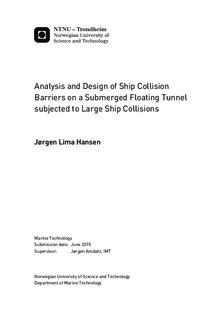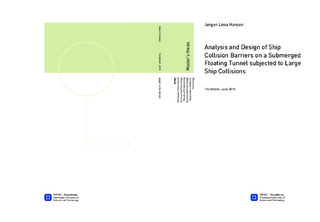| dc.description.abstract | The Norwegian Public Roads Administration (NPRA) is running the project "Ferry free coastal
route E39". One of the main challenging are regarding how to cross the wide and deep fjord on
the west coast of Norway. One of the bridge design considered is a combination of a floating
bridge and a submerged floating tunnel. The transition zone between those structural parts
is in special critical with respect to damage. This thesis focus at a ship collision barrier for
protection of the transition zone.
An impact with the ship collision barrier are taken as an accidental action. The design ship is
hence taken as the ship which have probability of occurrence less or equal to 1x10E-4. This
correspond to a cruise ship with design parameter; displacement 31 456 metric ton and impact
velocity 17.7 knots. The added mass coefficient was provided to be 0.2 and hence the total
kinetic energy for the design ship was determined to be 1565MJ. This is an severe amount of
energy which needs to be dissipated as strain energy in the ship and then barrier. Some energy
will also be dissipated by the inertia and drag forces, due to translation of the barrier.
A simplified analysis of a stiffened plate was performed by use of the nonlinear finite element
program LS-DYNA. The results of the analysis shows that the strength of the stiffeners were
in particular relevant for small displacements. While for larger displacement the plate carries
the load by membrane forces.
The ship collision barrier needs to be designed for dissipation of large amount of strain energy.
Therefore it was decided to built the structure like an ordinary ship like structure. This means
that the barrier consist of decks, vertical and transverse bulkheads which all are stiffened by
stiffeners. In this thesis the barrier is assumed to have a straight configuration with length
380m, breadth 20m, height 12m and a draft equal to 8m. The barrier is assumed to be a
freely floating structure only supported by buoyancy, inertia and drag forces. The barrier were
decided to be built of aluminium alloys. Alloy 5083-O is considered for the plates and alloy
6082-T6 is considered for the stiffeners.
The intact stability of the barrier was verified to be good. Since the barrier is a floating structure
it had to be ballasted down to the desired design draft. The aluminium cross section is
a relative light cross section. When the draft of the barrier was assumed to be 8m, the water
level of ballast water inside the cross section was determined to be about 7.7m.
By summarize the energy dissipated as strain energy in the ship and the barrier determined
by a strength design and a ductility design analysis, it was shown for the considered barrier
cross section that only about 1100MJ was dissipated. Therefore in order to dissipated the
total amount of kinetic energy as strain energy a stronger cross section should be considered.
If the analysis had accounted for energy lost due to translation of the barrier, the barrier cross
section may have been strong enough. However, integrated shared energy analyses to verify
this statement have not been completed. | |

